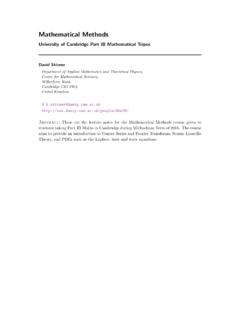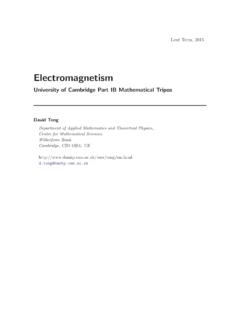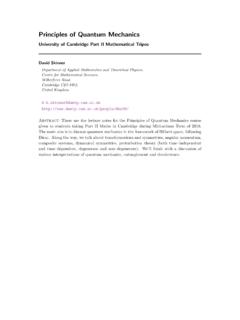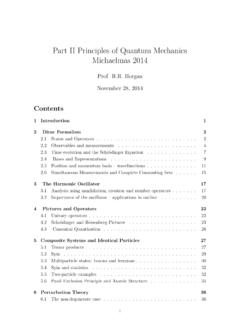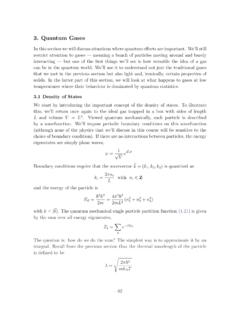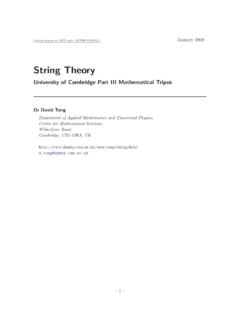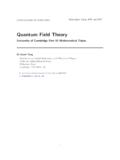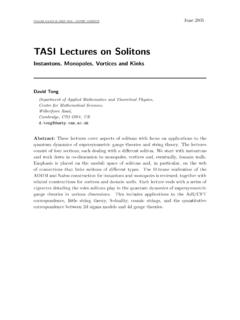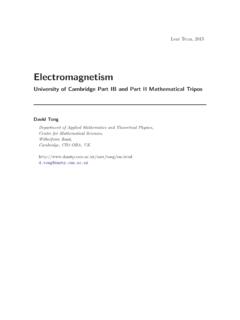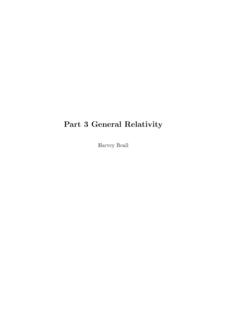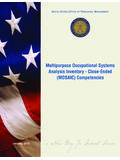Transcription of Statistical Physics - DAMTP
1 Preprint typeset in JHEP style - HYPER VERSION Lent Term, 2011 and 2012. Statistical Physics University of Cambridge Part II Mathematical Tripos Dr David Tong Department of Applied Mathematics and Theoretical Physics , Centre for Mathematical Sciences, Wilberforce Road, Cambridge, CB3 OBA, UK. 1 . Recommended Books and Resources Reif, Fundamentals of Statistical and Thermal Physics A comprehensive and detailed account of the subject. It's solid. It's good. It isn't quirky. Kardar, Statistical Physics of Particles A modern view on the subject which offers many insights. It's superbly written, if a little brief in places. A companion volume, The Statistical Physics of Fields covers aspects of critical phenomena. Both are available to download as lecture notes. Links are given on the course webpage Landau and Lifshitz, Statistical Physics Russian style: terse, encyclopedic, magnificent.
2 Much of this book comes across as remarkably modern given that it was first published in 1958. Mandl, Statistical Physics This is an easy going book with very clear explanations but doesn't go into as much detail as we will need for this course. If you're struggling to understand the basics, this is an excellent place to look. If you're after a detailed account of more advanced aspects, you should probably turn to one of the books above. Pippard, The Elements of Classical Thermodynamics This beautiful little book walks you through the rather subtle logic of classical ther- modynamics. It's very well done. If Arnold Sommerfeld had read this book, he would have understood thermodynamics the first time round. There are many other excellent books on this subject, often with different empha- sis. I recommend States of Matter by David Goodstein which covers several topics beyond the scope of this course but offers many insights.
3 For an entertaining yet tech- nical account of thermodynamics that lies somewhere between a textbook and popular science, read The Four Laws by Peter Atkins. A number of good lecture notes are available on the web. Links can be found on the course webpage: 2 . Contents 1. The Fundamentals of Statistical Mechanics 1. Introduction 1. The Microcanonical Ensemble 2. Entropy and the Second Law of Thermodynamics 5. Temperature 8. An Example: The Two State System 11. Pressure, Volume and the First Law of Thermodynamics 14. Ludwig Boltzmann (1844-1906) 16. The Canonical Ensemble 17. The Partition Function 18. Energy and Fluctuations 19. Entropy 22. Free Energy 25. The Chemical Potential 26. Grand Canonical Ensemble 27. Grand Canonical Potential 29. Extensive and Intensive Quantities 29. Josiah Willard Gibbs (1839-1903) 30. 2. Classical Gases 32. The Classical Partition Function 32.
4 From Quantum to Classical 33. Ideal Gas 34. Equipartition of Energy 37. The Sociological Meaning of Boltzmann's Constant 37. Entropy and Gibbs's Paradox 39. The Ideal Gas in the Grand Canonical Ensemble 40. Maxwell Distribution 42. A History of Kinetic Theory 44. Diatomic Gas 45. Interacting Gas 48. The Mayer f Function and the Second Virial Coefficient 50. van der Waals Equation of State 53. The Cluster Expansion 55. Screening and the Debye-H . uckel Model of a Plasma 60. 3. Quantum Gases 62. Density of States 62. Relativistic Systems 63. Photons: Blackbody radiation 64. Planck Distribution 66. The cosmic microwave background radiation 68. The Birth of Quantum Mechanics 69. Max Planck (1858-1947) 70. Phonons 70. The Debye Model 70. The Diatomic Gas Revisited 75. Bosons 77. Bose-Einstein Distribution 78. A High Temperature Quantum Gas is (Almost) Classical 81.
5 Bose-Einstein Condensation 82. Heat Capacity: Our First Look at a Phase Transition 86. Fermions 90. Ideal Fermi Gas 91. Degenerate Fermi Gas and the Fermi Surface 92. The Fermi Gas at Low Temperature 93. A More Rigorous Approach: The Sommerfeld Expansion 97. White Dwarfs and the Chandrasekhar limit 100. Pauli Paramagnetism 102. Landau Diamagnetism 104. 4. Classical Thermodynamics 108. Temperature and the Zeroth Law 109. The First Law 111. The Second Law 113. The Carnot Cycle 115. Thermodynamic Temperature Scale and the Ideal Gas 117. Entropy 120. Adiabatic Surfaces 123. A History of Thermodynamics 126. Thermodynamic Potentials: Free Energies and Enthalpy 128. Enthalpy 131. 1 . Maxwell's Relations 131. The Third Law 133. 5. Phase Transitions 135. Liquid-Gas Transition 135. Phase Equilibrium 137. The Clausius-Clapeyron Equation 140. The Critical Point 142.
6 The Ising Model 147. Mean Field Theory 149. Critical Exponents 152. Validity of Mean Field Theory 154. Some Exact Results for the Ising Model 155. The Ising Model in d = 1 Dimensions 156. 2d Ising Model: Low Temperatures and Peierls Droplets 157. 2d Ising Model: High Temperatures 162. Kramers-Wannier Duality 165. Landau Theory 170. Second Order Phase Transitions 172. First Order Phase Transitions 175. Lee-Yang Zeros 176. Landau-Ginzburg Theory 180. Correlations 182. Fluctuations 183. 2 . Acknowledgements These lecture notes are far from original. They borrow heavily both from the books described above and the online resources listed on the course webpage. I benefited a lot from the lectures by Mehran Kardar and by Chetan Nayak. This course is built on the foundation of previous courses given in Cambridge by Ron Horgan and Matt Wingate. I am also grateful to Ray Goldstein for help in developing the present syllabus.
7 I am supported by the Royal Society and Alex Considine. 3 . 1. The Fundamentals of Statistical Mechanics Ludwig Boltzmann, who spent much of his life studying Statistical mechan- ics, died in 1906 by his own hand. Paul Ehrenfest, carrying on the work, died similarly in 1933. Now it is our turn to study Statistical mechanics.. David Goodstein Introduction Statistical mechanics is the art of turning the microscopic laws of Physics into a de- scription of Nature on a macroscopic scale. Suppose you've got theoretical Physics cracked. Suppose you know all the funda- mental laws of Nature, the properties of the elementary particles and the forces at play between them. How can you turn this knowledge into an understanding of the world around us? More concretely, if I give you a box containing 1023 particles and tell you their mass, their charge, their interactions, and so on, what can you tell me about the stuff in the box?
8 There's one strategy that definitely won't work: writing down the Schr odinger equa- tion for 1023 particles and solving it. That's typically not possible for 23 particles, let alone 1023 . What's more, even if you could find the wavefunction of the system, what would you do with it? The positions of individual particles are of little interest to anyone. We want answers to much more basic, almost childish, questions about the contents of the box. Is it wet? Is it hot? What colour is it? Is the box in danger of exploding? What happens if we squeeze it, pull it, heat it up? How can we begin to answer these kind of questions starting from the fundamental laws of Physics ? The purpose of this course is to introduce the dictionary that allows you translate from the microscopic world where the laws of Nature are written to the everyday macroscopic world that we're familiar with.
9 This will allow us to begin to address very basic questions about how matter behaves. We'll see many examples. For centuries from the 1600s to the 1900s scientists were discovering laws of Physics that govern different substances. There are many hundreds of these laws, mostly named after their discovers. Boyle's law and Charles's law relate pressure, volume and temperature of gases (they are usually combined into the ideal gas law); the Stefan-Boltzmann law tells you how much energy a hot object emits; Wien's displacement law tells you the colour of that hot object; the Dulong-Petit 1 . law tells you how much energy it takes to heat up a lump of stuff; Curie's law tells you how a magnet loses its magic if you put it over a flame; and so on and so on. Yet we now know that these laws aren't fundamental. In some cases they follow simply from Newtonian mechanics and a dose of Statistical thinking.
10 In other cases, we need to throw quantum mechanics into the mix as well. But in all cases, we're going to see how derive them from first principles. A large part of this course will be devoted to figuring out the interesting things that happen when you throw 1023 particles together. One of the recurring themes will be that 1023 6= 1. More is different: there are key concepts that are not visible in the underlying laws of Physics but emerge only when we consider a large collection of particles. One very simple example is temperature. This is not a fundamental concept: it doesn't make sense to talk about the temperature of a single electron. But it would be impossible to talk about Physics of the everyday world around us without mention of temperature. This illustrates the fact that the language needed to describe Physics on one scale is very different from that needed on other scales.
